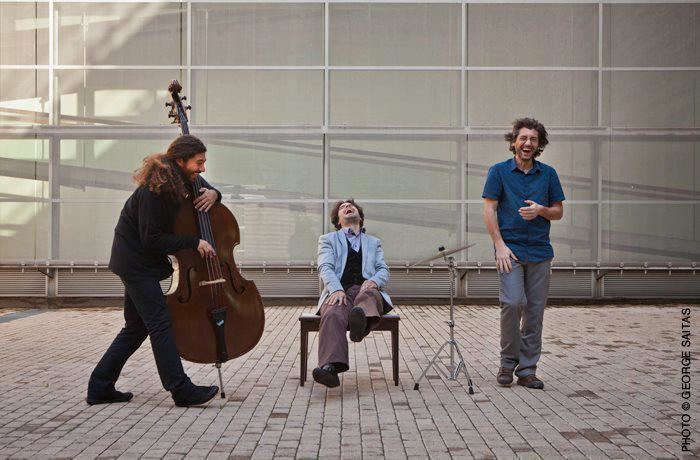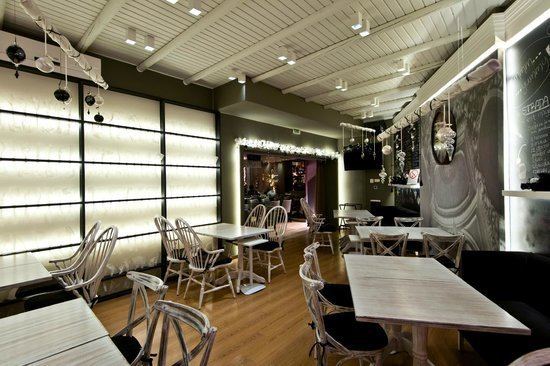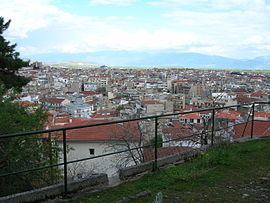Country Area 1,072.3 km2 Population 71,388 | Elevation 710 m | |
 | ||
Points of interest Aiani Archaeological Museum, Archaeological Museum of Kozani, Folklore Museum of Velventos | ||
Mayor Eleftherios Ioannidis (since 2014) | ||
Map of Kozani
Kozani (Greek: Κοζάνη, [koˈzani]) is a town in northern Greece, capital of Kozani regional unit and of West Macedonia region. It is located in the western part of Macedonia, in the northern part of the Aliakmonas river valley. The city lies 710 metres (2,329 feet) above sea level, 15 kilometres (9 miles) northwest of the artificial lake Polyfytos, 120 km (75 miles) south-west of Thessaloniki, between the mountains Pieria, Vermio, Vourinos and Askio. The population of the Kozani municipality is over 70,000 people. The climate of the area is continental with cold and dry winters, and hot summers.
Contents
- Map of Kozani
- Kozani sourdia macedonia greece www sourdos gr
- Macedonia 2014 kozani city
- Etymology
- Antiquity
- Ottoman period
- Balkan wars
- Modern times
- Economy
- Downtown sites of interest
- Nearby sites of interest
- Mass media
- Transport
- Government
- Province
- Climate
- Education
- Festivals and events
- Cuisine
- Notable people
- Sports
- Twin towns sister cities
- References

Kozani is the home of the Technological Educational Institute of Western Macedonia and the University of Western Macedonia, with about 15,000 students from all over Greece and other places. It is also the seat of West Macedonia's court of appeal, police department, fire brigade, the seat of the 1st Army Corps of the Hellenic Army and of the Bishop of Servia and Kozani.

One of the most important aspects of local folklore is Kozani's carnival at the end of the winter, which retains much of the profanity of the ancient Dionysiac cult. Kozani is renowned in Greece and abroad for the production of Saffron (Krokos Kozanis), in the nearby town of Krokos.

Kozani is a transport node between Central Macedonia, Thessaly and Epirus. The nearest airport is Filippos Airport, 4 kilometres (2 miles) from the city, IATA code: KZI. The airport was first opened in the mid-20th century. Kozani is situated near the Egnatia Highway, which connects the coast of the Ionian Sea with Thessaloniki and Turkish borders.
Kozani sourdia macedonia greece www sourdos gr
Macedonia 2014 kozani city
Etymology
According to prevailing opinion in Greece, the name comes from the village of Epirus Kósdiani, the origin of settlers of Kozani in 1392. The settlement was first named Kózdiani, which then, it was changed into Kóziani, and in the end into Kozáni.
Antiquity
Antiquities from the prehistoric to the Byzantine period have been unearthed in many sectors of the city. In the east part of Kozani, an ancient necropolis has been found, dating to the early Iron Age. During Philip II of Macedon's reign, the region was named Elimeia, which was part of Upper Macedonia and probably in the same place there was a town named Tyrissa. In the south-west of the modern city, on Siopoto hill, there was a settlement named Kalyvia, between 1100 and 1300, traces of which are still preserved.
Ottoman period
Kozani was probably founded by Christian settlers who, after the Ottoman conquest, withdrew from the plains of Macedonia into the mountains, during the 14th and 15th centuries. Its secure position soon attracted other Christians expelled from Epirus, in 1392. Together with the settlers from Epirus, many cattle-breeders moved in the region.
The first recorded mention of Kozani is in an Ottoman register of 1528, as a settlement with 91 houses, 23 singles and 15 widows. One of the most important colonizers of Kozani was the chief shepherd Ioannis Trantas, who settled about 100 families. His son, Charisios Trantas, managed to obtain a Sultan's firman in 1664, according to the terms of which the town came under the protection of the Sultan's mother, was endowed with many privileges, and became forbidden for the Turks to settle in.
In 1664, the magnificent church of Agios Nikolaos was built. In 1668, the library and the famous school of Kozani were founded. During the 17th and 18th century, commercial relations with the countries of central Europe gave the opportunity for the city to flourish economically. During the 19th century, as foreign travellers relate, the population of the town was Greek, and was growing (Leake 1835:305 and Bouè 1854:87).
The town's growth was disrupted in 1770, because of conflict that erupted between Kozani's local inhabitants and Kozanite merchants in central Europe, who contributed to the town's prosperity; even more catastrophically, the city was pillaged by Turkish beys in 1770. A subsequent incursion by Aslan bey, in 1830, ravaged the city immensely. In 1855 next to St. Nicholas Church a 26 meters high bell tower was built, which would become the symbol of the city. In 1939, a clock was added to the top of the tower, donated by Greek American Konstantinos Mamatsios. According to the 1904 population census, 12,000 Greeks and 350 Vlachs were living in Kozani at the time.
In the late 19th and early 20th century, Kozani was part of the Manastir Vilayet of the Ottoman Empire.
Balkan wars
The Greek army entered Kozani on 11 October 1912, during the First Balkan War, after its victory against the Ottoman army in the Battle of Sarantaporo. By this time, the population of the town was 12,000 Orthodox Greeks. In 1923, during the population exchange between Greece and Turkey, about 1,400 Greek families from Pontus and Asia Minor were settled in Kozani.
Modern times
In the 20th century, the city grew tremendously, as lignite reserves in the area started being used by Public Power Corporation, making Kozani the foremost producer of electrical power in Greece. An earthquake that occurred in the region on 13 May 1995, with a magnitude of 6.6 on the Richter scale caused only property damage.
The city now combines modern with old faries architecture. Some magnificent buildings are the clock tower, the tow hall, the folklore museum, the "Valtadoreio" Gymnasium, the National Bank of Greece building, the "Ermioneion" Hotel and the mansions of Georgios Lassanis and Grigorios Vourkas. The Municipal Library of Kozani called "Kovendareios" is the second biggest in Greece, and it has 150,000 books, rare publications, valuable documents, and one of the rare copies of Rigas Feraios' charter. For this reason Kozani was included in the National Cultural Network of Cities with object the promotion of the Book and Reading. The Institute of Book and Reading was established and Kozani is now known as City of Books. Today Kozani is the administrative, commercial, economic, and transport centre of the region of West Macedonia.
Economy
The city is mostly known for its important contribution to the Greek electricity supply, and a large part of the population works in the Public Power Corporation's Agios Dimitrios Power Plant, the largest power plant in Greece. The Ptolemaida Basin hosts the Western Macedonia Lignite Center, which is accountable for the production of 40% of the electric energy of the country.
Other famous products are marble, Saffron, (Krokos Kozanis), fruits, local wines and specialized arts and crafts industry. The Commercial Exhibition of Kozani takes part in the Exhibition Centre of West Macedonia in Koila Kozanis every September. Many firms from Greece and other Balkan countries participate, especially with local products.
While Kozani remains a regional banking center, the Kozani-based Co-operative Bank of Western Macedonia however failed the stress test conducted by the Bank of Greece and subsequently was liquidated in December 2013.
Downtown sites of interest
Nearby sites of interest
Mass media
There are some telecommunications companies, TV and radio stations, newspapers, magazines, and web portals based in Kozani. The television channels are West Channel, TOP Channel and Flash TV. Top-circulation newspapers include Chronos, Grammi, Tharros and others.
Transport
Kozani is accessed with Motorway Egnatia (or GR-2, or E90) from Ioannina and Thessaloniki, GR-3 (or E65) from Larissa and Florina, GR-4 and GR-20.
The public transit in the city is provided by minibuses, and between the centre and the municipal departments, it is provided by Transit buses. The traffic problems of the city have become more severe during the last few years.
Government
The municipality Kozani was formed at the 2011 local government reform by the merger of the following 5 former municipalities, that became municipal units:
The total population is 71,388 (2011). It is developing into a nodal town of the Western Balkans, with areas and activities of a wider regional nature. Within this context, the municipality of Kozani is creating a modern satellite town, the Kozani Zone of Alternate Urban Planning (ZEP). The Municipal Corporation of alternate planning and development of Kozani S.A.(DEPEPOK) was established in order to implement the projects of the ZEP.
The ZEP is strategically located on 50 ha south-west of Kozani, and aims to become a model development centre, attracting an urban population and economic activities from throughout Western Macedonia in Greece and the Western Balkans.
Other known neighborhoods of Kozani are Sk'rka, Ipirotika, Gitia, Agios Athanasios, Platania.
Province
The province of Kozani (Greek: Επαρχία Κοζάνης) was one of the provinces of the Kozani Prefecture. Its territory corresponded with that of the current municipalities Kozani (except a few villages that were part of the Eordaia province) and Servia-Velventos. It was abolished in 2006.
Climate
Under the Köppen climate classification, Kozani has a humid subtropical climate (Cfa), with considerable hot-summer continental climate (Dfa) influences. Rainfall is spread evenly throughout the year.
The climate of Kozani has changed over the years as a result of the environmental degradation brought by the extensive lignite mining in the area. The lignite mine is one of the largest in Eastern Europe; due to the constant expansion of the mining activities in the area several communities have already been moved closer to city of Kozani and more are scheduled to be moved by 2020. Given that the main source of income for the city of Kozani is the lignite mine and the thermal power station in the area local residents are often biased about the environmental catastrophe brought on by these activities.
Education
There are 18 Primary schools in Kozani, and another 8, in the municipal departments of Vatero, Kariditsa, Koila, Lefkovrysi, Lefkopigi, Nea Charavgi, Xirolimni and Petrana. The Gymnasiums of the city are 8, and there are two more in the municipal departments of Lefkopigi and Xirolimni. There are also 4 Lyceums, 4 Technical Schools (TEE), some Business Schools and one municipal Odeum.
Kozani is the home of the Technological Educational Institute of Western Macedonia - one of the biggest in Greece (founded on 1976). Three of its Faculties are in the city - the Faculty of Administration and Economy, Technological Applications and Health. (The rest of them are in other places of West Macedonia). The seat of the University of Western Macedonia and its Faculty of Engineering, they are also in Kozani. The University was founded in 2002.
Festivals and events
Kozani carnival is one of the most important events in the region, taking place the end of the winter. The most interesting local celebration during the carnival are the Fanoi (great bonfires), which are lit in the squares of Kozani. Around them, people sing and dance mainly scoptic songs and local dances, such as the best known song in the region - the Enteka of Kozani, often called Kozani's "national anthem". All celebrations become more exciting on the Sunday of the last week, after the carnival parade, when bonfires are lit all over the town which burn until the early morning hours.
At the end of summer Lassaneia Events are organised. They consist of theatrical representations, concerts, athletic events etc. The name "Lassaneia" comes from Georgios Lassanis, who was from Kozani and participated in the Greek War of Independence. A part of those events is also the new authors song festival "Nikolas Asimos".
Niaimeros is a fair in the north of the city in the Niaimeros place. It takes place on the first Tuesday of October. It used to last 9 days (niaimeros = nine days), but now it lasts only 3 days.
Official local public holidays are the celebration for the liberation of the city from the Turks on 11 October and Saint Nicolas day - Kozani's patron - on 6 December.
The municipal Band is named Pandora. It was founded in 1902, and it takes part in all the events and celebrations.
Cuisine
A typical dish in Kozani is the so-called Giaprakia. The main ingredients are meat and rice in salty carbage-leaf, having the shape of an egg. It is used often as Christmas food. Kichi (Kozanitiko kichi) is called another local dish, which is actually a cheese pie with circular-snail form.
Notable people
Sports
Twin towns – sister cities
Kozani is twinned with:
